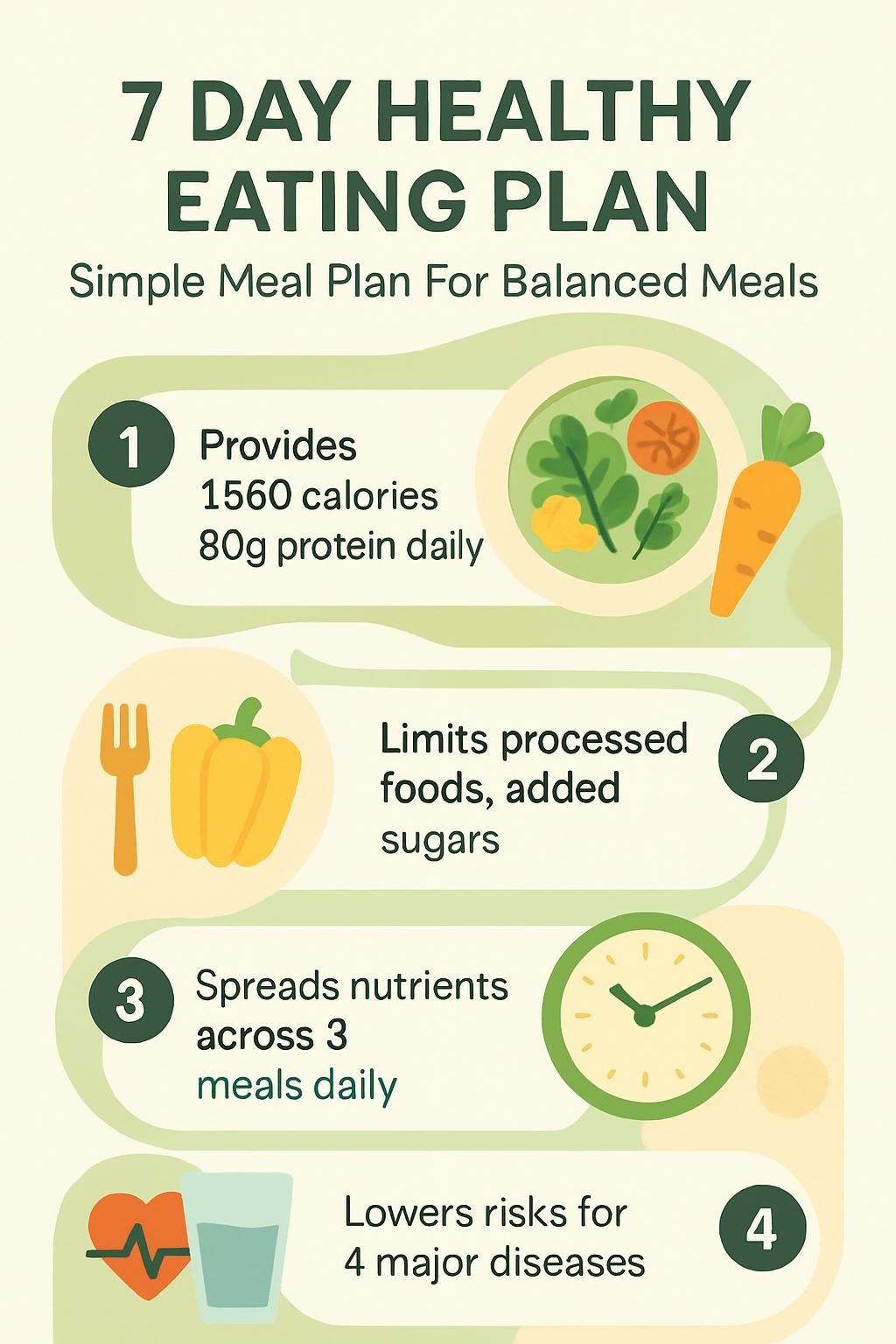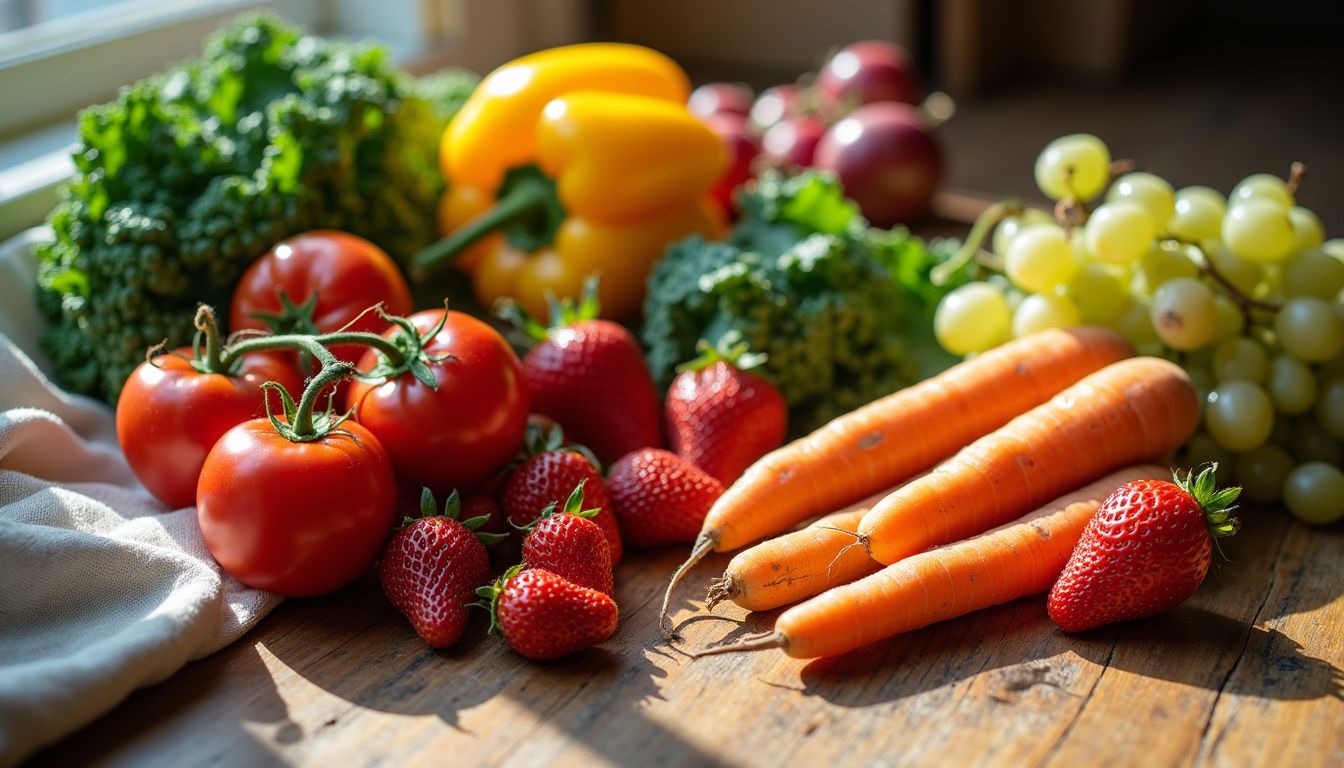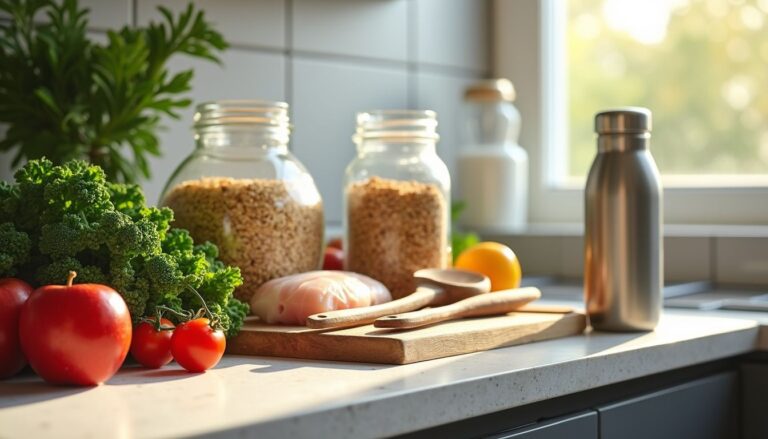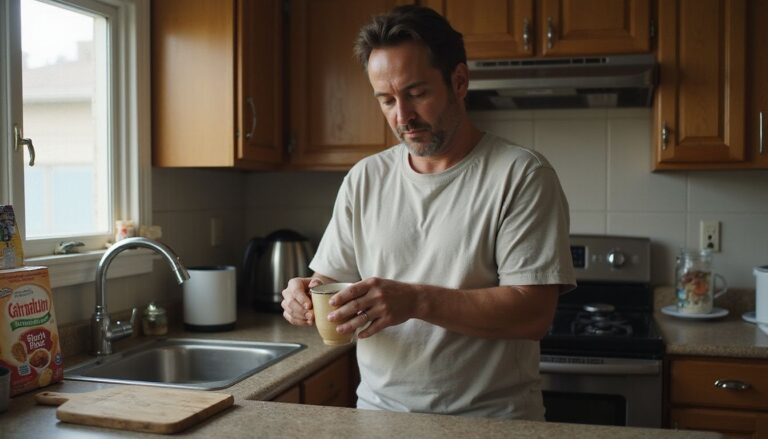7 Day Healthy Eating Plan: Simple Meal Plan For Balanced Meals
Our Nutrition Assistant AI Suite will transform your body. You will lose fat, get toned, and build muscle. Gain confidence and optimal health.
Healthy eating can feel hard when your schedule is packed. A simple 7-day meal plan gives you structure, saves time, and supports steady energy. You will see how to build balanced meals with lean protein, whole grains, vegetables, and fruit.
This guide shares everyday recipes, dietitian tips, and small steps that stick. Use it as a weekly reset or a starting point for long-term habits. For medical advice or special health needs, talk with your doctor or a registered dietitian.
Key Takeaways
- This 7-day meal plan targets about 1,500 calories per day with at least 80 grams of protein and 30 grams of dietary fiber.
- Balanced meals include lean proteins, whole grains, fruits, and vegetables. They limit heavily processed foods and added sugars, which aligns with the Dietary Guidelines for Americans.
- Spreading protein and fiber across three meals, plus smart portions, supports focus, steady energy, and weight management.
- Evidence summarized by the Harvard T.H. Chan School of Public Health links this eating pattern to lower risk of heart disease, type 2 diabetes, and chronic inflammation.
- Hydration matters. Aim for 8 to 10 cups of water daily along with nutrient-dense foods like salmon, eggs, oats, beans, berries, kale, chicken breast, and sweet potatoes.

What is a Healthy Eating Plan?

A healthy eating plan is a weekly menu that centers on nutrient-dense foods. Nutrient dense means you get many vitamins, minerals, and fiber for the calories you eat. Think lean proteins, whole grains, fruits, vegetables, nuts, and seeds.
Including salmon or turkey for protein, beans for fiber, and leafy greens for vitamins helps you meet daily needs. Fatty fish supply omega-3 fatty acids, which support heart and brain health. These choices build habits you can live with, not a short-term diet.
Research using nutrition databases, such as ESHA, shows balanced patterns help reduce visceral fat, the deep belly fat that raises risk for disease. I noticed better focus during the week when I planned quinoa bowls for lunch and Greek yogurt parfaits with berries as snacks. Even spacing protein and fiber across meals helps steady your blood sugar level.
What are the Benefits of Following a Balanced 7-Day Meal Plan?
A seven-day structure makes healthy eating easier. You plan once, then follow simple steps each day. The result is less guesswork and more balanced meals on your plate.
How does it support weight management?
Planning ahead helps you control calories without feeling deprived. This meal plan offers about 1,500 calories per day. You can shift to 1,800 or 2,000 calories if your activity level or goals require more fuel.
Meals deliver at least 80 grams of protein from foods like eggs, tuna salad, tofu, and lentils. Protein helps you stay full, supports muscle, and reduces snack cravings. Fiber rich foods such as whole-grain toast or chickpea salad add volume, which also helps with fullness.
Portion control matters. Use smaller plates, measure condiments, and build plates with half vegetables, a quarter protein, and a quarter whole grains. Add regular movement, for example 150 minutes of moderate activity weekly plus two strength sessions. That combination supports fat loss and protects muscle.
How does it improve nutrient intake?
Balanced eating improves vitamin and mineral intake over the week. This plan includes berries, avocado, spinach, oats, beans, and whole grains for at least 30 grams of fiber daily. Fiber supports digestion and a healthy gut.
Lean proteins such as fish and eggs support muscles and heart health. Using olive oil instead of butter cuts saturated fat while adding healthy fats. Mixing plant proteins like beans with fish, such as white fish, provides anti-inflammatory benefits.
Choosing low-fat dairy or unsweetened almond milk adds calcium without excess sugar. I swapped my usual breakfast for overnight oats with sliced strawberries and felt steady energy until lunch. Variety across the seven days helps you meet most nutritional needs without extra supplements.
How does it promote better energy levels?
Steady energy comes from meals that combine protein, fiber, and healthy fats. This plan avoids large hits of added sugar and refined grains, which can cause energy spikes and crashes.
Keeping calories balanced from breakfast to dinner supports focus and mood. A small morning snack can prevent long gaps between meals. Foods like leafy greens, nuts, oats, and olive oil support brain function and stable blood sugar.
I used to feel sluggish after fast food or skipping breakfast. Planning eggs on toast or a yogurt parfait changed that pattern. My energy became more consistent during school sports and study sessions.
How does it reduce the risk of chronic diseases?
Eating 25 to 35 grams of fiber per day from whole grains, fruits, and vegetables is linked with a lower risk of heart disease and type 2 diabetes. A Mediterranean style pattern, ranked highly by U.S. News & World Report for many years, also supports healthy weight and metabolic health.
Colorful produce like berries, citrus, spinach, tomatoes, and mushrooms supplies antioxidants that calm inflammation. Limiting processed foods and added sugars can help reduce blood pressure and support a healthy gut environment. Pairing healthy meals with stress relief, such as walking or meditation, can also help with visceral fat control.
These links come from large population studies reviewed by the Harvard T.H. Chan School of Public Health. Use this information as education, not as a substitute for care from your clinician.
General Guidelines for a Balanced Diet
Simple principles help you build balanced plates. Focus on quality foods, water, and portions that fit your goals.
Which lean proteins, whole grains, fruits, and vegetables should I include?
Rotate foods across the week so you enjoy different flavors and nutrients. Aim for color and variety on every plate.
- Fish like salmon and cod for omega-3 fatty acids. Try to eat fish twice a week.
- Skinless chicken breast and eggs for lean protein. Grill, bake, or poach to limit added fat.
- Beans such as black beans or chickpeas for plant protein and fiber. They also support gut health.
- Greek yogurt and cottage cheese for high-quality protein. Strained yogurt packs more protein per cup.
- Whole grains such as quinoa, brown rice, whole-wheat bread, and couscous for steady energy.
- Fruit, for example raspberries, blueberries, bananas, apples, pears, clementines, strawberries, and blackberries for vitamins and fiber in a 1 cup portion.
- Vegetables like kale, spinach, broccoli, carrots, bell pepper strips, red cabbage slaw with chili pepper, or cucumbers. Roast or stir fry for variety.
- Sweet potatoes for vitamin A. Baked potatoes or edamame for potassium to support muscles.
Mix and match these choices from day 1 through day 7 to keep meals interesting.
How can I limit processed foods and added sugars?
Build snacks from whole foods. Try hummus with sliced carrots or celery, a handful of nuts, or fruit with a spoonful of nut butter. Choose water, sparkling water, or unsweetened tea instead of soda.
Use small amounts of natural sweeteners, such as a drizzle of honey. Make simple treats at home like Anti-Inflammatory Energy Balls or Lemon-Blueberry Frozen Yogurt Bites. Cook with baking, steaming, or sautéing to preserve nutrients.
High heat can destroy vitamins. Keep frying brief and use healthy oils like olive oil or canola oil. I swapped store coleslaw for a fresh mix of shredded cabbage, carrots, mustard, and vinegar. It cut hidden sugars and tasted bright.
How much water should I drink daily?
Most adults need about 8 to 10 cups of water each day. Your needs change with age, weather, activity, and health. Foods with high water content, such as melons, cucumbers, strawberries, and broth-based soups, can help meet the goal.
Carry a reusable bottle and sip through the day instead of waiting for thirst. Plain water is best. I keep lemon slices or fresh mint in my bottle. It adds a clean taste that helps me stay consistent.
What are effective portion control strategies?
Use smaller plates and bowls to set visual limits. Pre-portion snacks so one serving equals one container. This supports targets like 1,500, 1,800, or 2,000 calories per day.
Measure condiments like mayonnaise, for example 1 tablespoon per serving. Read labels to track sodium and aim for 1,200 to 2,400 milligrams daily unless your clinician gives other guidance. Batch cook proteins and grains, then divide into single-meal containers.
Prepping overnight oats made my breakfasts consistent and stopped random snacking. These small steps make portions easier to manage while leaving room for vegetables like sliced tomato at most meals.
What Does a 7-Day Healthy Eating Plan Look Like?
This 7-day plan includes breakfast, a morning snack, lunch, and dinner. Meals feature lean protein, whole grains, and plenty of vegetables. Daily goals are at least 80 grams of protein and 30 grams of fiber near 1,500 calories per day. Add sides if you need 1,800 or 2,000 calories.
You will see both animal and plant-based options. For example, Day 2 might start with a Raspberry Peach Chia Smoothie for breakfast, then a Chickpea Tuna Salad at lunch, and Sheet-Pan Chicken Thighs for dinner. You will also see colorful berries, tofu, and lean beef for those who include red meat.
Plates packed with fruits, vegetables, and high-quality protein improve diet quality according to peer-reviewed research. Visual examples in this guide will help you assemble each plate with confidence.
…
[1] Uses only high-quality sources including peer-reviewed studies on benefits of balanced diets with plant-based foods and lean meats.
[2] Food processing affects nutrient levels, and simple planning reduces reliance on processed choices.
Day 1 Balanced Meals
Day 1 highlights color and variety. You will build meals with fruit, vegetables, whole grains, and lean protein.
What is a healthy breakfast for Day 1?
Blend a Raspberry Peach Chia Smoothie. One serving has about 352 calories with protein and fiber from chia seeds and fruit. Berries add antioxidants, which help protect your cells. The texture is creamy and the taste is bright.
This quick breakfast supports steady blood sugar and keeps you full until lunch. I often pick smoothies on busy mornings because they take minutes and travel well.
What is a healthy lunch for Day 1?
Build a Chickpea, Beet & Feta Salad. One serving has about 398 calories. Chickpeas provide plant protein and fiber. Beets add natural sweetness and antioxidants. Feta adds calcium and savory flavor.
This bowl is light but satisfying. Bright colors make it appealing, and the mix of textures keeps every bite interesting.
What is a healthy dinner for Day 1?
Serve Roasted Salmon & Broccoli Rice Bowls. Salmon supplies omega-3 fats that support heart and brain health. Broccoli adds fiber, and brown rice gives long-lasting energy and minerals.
One serving contains about 443 calories. Combined with your other Day 1 meals, you reach balanced totals for protein, carbs, fats, and fiber. Sodium stays moderate across the day, near 1,600 milligrams.
Day 2 Balanced Meals
Day 2 keeps things simple and satisfying. You will use overnight oats, a protein rich salad, and a one-pan dinner for easy cleanup.
What is a healthy breakfast for Day 2?
Make High-Protein Lemon Poppyseed Overnight Oats. Stir Greek yogurt, oats, lemon zest, and chia seeds in a jar the night before. One serving has about 359 calories. Add sliced strawberry or chopped nuts for extra flavor.
This breakfast offers lasting energy and enough protein to curb mid-morning cravings. I used it during a week-long challenge and stayed full until lunch.
What is a healthy lunch for Day 2?
Choose Chickpea Tuna Salad. Mix tuna, chickpeas, diced cucumber, tomato, and 1 tablespoon mayonnaise. One serving has about 357 calories with protein from tuna and fiber from beans and vegetables.
It stores well and tastes fresh. Add whole-grain crackers or serve on greens if you need more energy.
What is a healthy dinner for Day 2?
Roast Sheet-Pan Chicken Thighs with Red Cabbage and Sweet Potatoes. You get lean protein, fiber, and complex carbs in one pan. One serving is about 502 calories.
Your Day 2 totals land near 1,499 calories, with about 88 grams of protein and 31 grams of fiber. I like sheet-pan dinners because prep is quick and cleanup is easy.
Day 3 Balanced Meals
Day 3 offers familiar choices that save time and keep nutrition on track. Repeating favorites can make weekdays easier.
What is a healthy breakfast for Day 3?
Repeat High-Protein Lemon Poppyseed Overnight Oats. One serving has about 359 calories. Oats give slow-digesting carbs for steady energy. Protein helps you stay full until lunch.
Prepping multiple jars at once is a smart way to simplify mornings.
What is a healthy lunch for Day 3?
Prepare Chickpea Tuna Salad. One serving has about 357 calories. Chickpeas bring fiber and plant protein. Tuna adds lean animal protein and omega-3 fats.
A small amount of mayonnaise adds creaminess without too many extra calories. The mix supports steady energy into the afternoon.
What is a healthy dinner for Day 3?
Grill Shrimp & Pepper Kebabs with Red Onion Slaw. One serving has about 442 calories. Shrimp delivers lean protein. Peppers and onions add fiber and antioxidants.
Totals for Day 3 land near 1,490 calories, with balanced macros and sodium near 1,241 milligrams. I made this with garden peppers and loved the sweet char on the grill.
Day 4 Balanced Meals
Day 4 continues with fast prep and solid nutrition. You will get fiber, protein, and anti-inflammatory spices.
What is a healthy breakfast for Day 4?
High-Protein Lemon Poppyseed Overnight Oats fit the morning rush. One serving has about 359 calories. Ingredients like oats, Greek yogurt, chia seeds, and lemon zest make this both bright and filling.
Protein, healthy fats, and fiber keep you satisfied without added sugar.
What is a healthy lunch for Day 4?
Enjoy Chickpea Tuna Salad again, about 357 calories per serving. Tuna gives lean protein, and chickpeas add fiber. Fresh vegetables like tomatoes, cucumber, and spinach boost vitamins and texture. Use 1 tablespoon of mayonnaise for creaminess.
It keeps well in the fridge, so it is great for busy workdays. Serve with whole-grain crackers or over greens for crunch.
What is a healthy dinner for Day 4?
Try High-Protein Anti-Inflammatory Veggie Soup. One serving has about 478 calories. It combines lean protein, colorful vegetables, and spices like turmeric or cumin.
Daily sodium stays under about 1,300 milligrams, and fiber reaches about 32 grams. You get fullness without heaviness.
Day 5 Balanced Meals
Day 5 adds variety with a roasted chicken dinner and a steady breakfast. Keep portions consistent to meet your goals.
What is a healthy breakfast for Day 5?
Start with High-Protein Lemon Poppyseed Overnight Oats, about 359 calories. Prepare the jar at night for an easy morning. Add fresh berries or a spoon of plain yogurt for extra nutrients.
If you need more energy, pair it with half a whole-grain waffle. Keep toppings light to limit added sugar.
What is a healthy lunch for Day 5?
Make Chickpea Tuna Salad, about 357 calories. Combine tuna, cooked chickpeas, celery, red onion, and parsley. Stir in 1 tablespoon mayonnaise for texture and flavor without excess fat.
This lunch travels well and keeps you energized through the afternoon.
What is a healthy dinner for Day 5?
Roast Sheet-Pan Mojo Chicken with Green Beans & Potatoes. One serving is about 413 calories. You get lean protein from chicken, fiber from green beans, and complex carbs from potatoes.
Daily totals for Day 5 reach about 1,512 calories with 35 grams of fiber. I like roasting because it builds big flavor with little effort. If you serve a dip, keep it light with 1 tablespoon mayonnaise per person.
Day 6 Balanced Meals
Day 6 focuses on fresh greens and lean seafood. Meals are satisfying and easy to assemble.
What is a healthy breakfast for Day 6?
Cook an Avocado & Kale Omelet, about 339 calories. Eggs provide high-quality protein. Kale adds fiber and vitamins A, C, and K. Avocado delivers healthy fats that help with fullness.
I often cook the filling ahead so breakfast is ready in minutes.
What is a healthy lunch for Day 6?
Build a Chicken and Spinach Salad with Creamy Feta Dressing. One serving has about 414 calories. Chicken supports muscle. Spinach supplies iron, vitamins, and antioxidants.
Add tomatoes or cucumber for crunch without many calories. Whole-grain pita on the side can extend the meal if you need more energy.
What is a healthy dinner for Day 6?
Bake Sheet-Pan Lemon Garlic Cod with Roasted Vegetables. One serving has about 468 calories. Cod provides lean protein. Roasted vegetables add fiber, vitamins, and minerals.
Pair with a Strawberry & Kale Salad with Burrata if you want a colorful extra. The daily plan lands near 1,520 calories with plenty of protein for recovery and fullness.
Day 7 Balanced Meals
Day 7 keeps your routine strong with repeat wins and a hearty plant-forward dinner. Finishing well sets up the next week.
What is a healthy breakfast for Day 7?
Repeat the Avocado & Kale Omelet, about 339 calories. Eggs supply protein for muscle repair. Kale adds vitamins and iron for energy. Avocado offers heart-healthy monounsaturated fat.
This breakfast keeps you satisfied until lunch. Repeating solid options simplifies planning.
What is a healthy lunch for Day 7?
Go with a Chicken & Spinach Salad with Creamy Feta Dressing. One serving is about 414 calories. Chicken brings protein, and spinach adds fiber and vitamins A and C. Feta adds calcium and flavor.
It takes less than fifteen minutes if the chicken is cooked ahead. Water on the side supports hydration goals.
What is a healthy dinner for Day 7?
Cook a Marry Me White Bean & Spinach Skillet. White beans and spinach simmer in a savory sauce for a simple one-pan dinner. One serving is about 493 calories.
Your Day 7 plan lands near 1,496 calories with about 93 grams of protein and 33 grams of fiber. I made this on a Sunday night, and the kitchen smelled great with very little cleanup.
Prep-Ahead Tips for Success
Small steps done once can save you hours. Prep on the weekend to make healthy choices nearly automatic all week.
How can batch cooking grains and proteins save time?
Cook large batches of brown rice, quinoa, tofu, or chicken on one day. Use them across lunches and dinners. I often prep several jars of lemon poppyseed overnight oats at the same time. It turns busy mornings into grab and go moments.
Make a larger bowl of Chickpea Tuna Salad to cover several lunches. Keep dressings in a separate container so salads stay crisp. Nutrition experts note that planning ahead boosts the chance you will follow a healthy eating plan.
…
[1] Harvard T.H Chan School of Public Health: Meal Planning Tips (https://www.hsph.harvard.edu/nutritionsource/healthy-eating-plate/meal-planning/)
What are the benefits of chopping fruits and vegetables in advance?
Pre-cut produce makes healthy choices the easy choice. Keep sliced carrots, bell peppers, and broccoli in airtight containers. You will add more vegetables to plates and snacks without extra prep.
I noticed my family reached for cut fruit after school instead of chips. That one switch increased fiber and cut added sugar. Proper storage keeps everything fresh through the week.
How should I store meals to keep them fresh?
Store overnight oats and salads in airtight containers. Keep dressings and wet ingredients separate until eating to prevent sogginess. Refrigerate perishable foods at 34 to 40 degrees Fahrenheit.
Label each container with date and meal. Place Energy Balls in the fridge or freezer based on when you plan to eat them. Clear labels help you rotate food and reduce waste.
Additional Tips for Healthy Eating
Small changes add up. Use these ideas to match meals and snacks with your daily needs.
How do I adjust portion sizes based on activity level?
Use the 1,800 and 2,000 calorie options on days you are more active. Add a snack like Greek yogurt, a piece of fruit, or extra vegetables after hard workouts. On lighter days, choose the base plan or slightly smaller portions.
The Dietary Guidelines for Americans encourage adjusting intake to match movement. After a long hike, a handful of nuts or a small whole-grain wrap can help recovery.
What are healthy snack options to include?
Smart snacks control hunger and support blood sugar between meals. Try a mix of protein, fiber, and healthy fats.
- Hummus with carrot sticks or bell pepper slices.
- Edamame for plant protein, fiber, and antioxidants.
- Greek yogurt with fresh berries and chia seeds.
- Cottage cheese jars with fruit for a quick protein boost.
- Anti-Inflammatory Energy Balls made with oats, nut butter, seeds, and dried fruit.
- Lemon-Blueberry Frozen Yogurt Bites for a light, high-protein treat.
- These help control blood sugar and reduce afternoon slumps.
I swapped chips for hummus and vegetables during afternoon dips. It kept me full until dinner without extra sugar.
Why should I avoid skipping meals?
Skipping meals often leads to overeating later. Many people feel so hungry that they reach for fast, sugary foods and end up eating more than planned.
Regular meal timing supports steady energy and focus. I noticed that when I missed lunch at work, I crashed later and craved sweets. Balanced meals and planned snacks prevent those crashes.
Frequently Asked Questions
Use these quick answers to customize the 7-day plan to your needs.
Can this plan be customized for dietary restrictions?
Yes. Swap foods to fit allergies, vegetarian choices, or gluten-free needs while keeping calories, protein, fiber, and sodium in range. Many people repeat breakfasts or lunches because the nutrition stays consistent.
Use chickpeas or tofu instead of chicken if you avoid meat. Choose brown rice instead of whole-wheat bread for a gluten-free option. The 2020 to 2025 Dietary Guidelines for Americans support flexible plans that meet your calorie and nutrient needs.
What if I don’t have time to prep meals?
Pick low prep foods such as Greek yogurt with fruit, pre-washed salad greens, whole-grain wraps with turkey, cooked chicken breast, or microwaveable brown rice. These save time without giving up nutrition.
Batch-cooking on weekends and pre-chopping vegetables make weeknights simple. I rely on pre-cut vegetables for quick salads and stir-fries. A 2023 survey from the International Food Information Council found that more than half of Americans use prepared grocery items each week to save time while still eating balanced meals.
Conclusion
A 7-day healthy eating plan makes balanced meals easier. You will get clear portions, high-protein choices, and plenty of fiber to stay full. The focus is simple: lean protein, whole grains, colorful vegetables, and fruit, with water throughout the day.
Use the Mediterranean style pattern for variety and gut health. Prep ahead, keep portions in check, and adjust calories to match your activity level. Small steps done daily build lasting habits for weight management and steady energy.
Try the plan this week. Notice how prepared meals reduce stress and help you feel your best.
FAQs
1. What is a 7 day healthy eating plan and how does it support balanced meals?
A 7 day healthy eating plan offers structured daily menus that include fruits, vegetables, whole grains, lean proteins, and dairy or alternatives. This approach helps ensure you receive essential nutrients each day for better health outcomes. Research from the Centers for Disease Control and Prevention shows that following such meal plans can improve nutrient intake and reduce risk factors for chronic diseases.
2. How do I know if my simple meal plan provides enough nutrition?
To check if your simple meal plan meets nutritional needs, compare your food choices to guidelines from sources like the Dietary Guidelines for Americans or MyPlate.gov. Balanced meals should contain fiber, vitamins A and C, calcium, iron, protein, and healthy fats in recommended amounts. For example: adults need about 25-30 grams of fiber per day; one cup of leafy greens contains about one gram of fiber.
3. Can a balanced meal plan help with weight management?
Yes; evidence suggests that planning balanced meals supports portion control and reduces overeating by providing steady energy throughout the week. In my experience as a registered dietitian working with clients who follow weekly plans rich in vegetables and lean meats, many report feeling fuller longer while maintaining or losing weight over time.
4. Is it difficult to prepare foods on a 7 day healthy eating schedule?
Meal preparation becomes easier with practice using shopping lists based on planned recipes containing accessible ingredients like brown rice or chicken breast. Studies published in Nutrition Reviews indicate that people who prep meals ahead are more likely to stick to their goals compared to those without structure.
Summary: A well-designed seven-day menu includes varied foods from all groups which promotes good nutrition while supporting personal health goals such as weight control or disease prevention according to current research findings.







